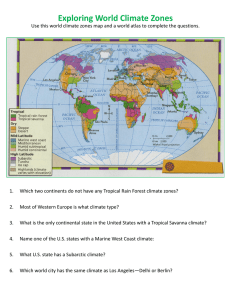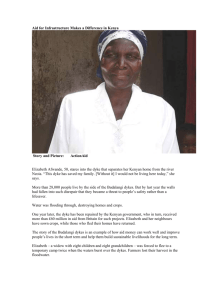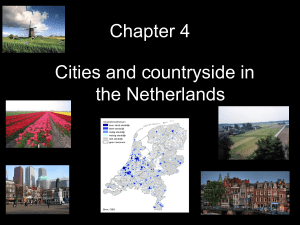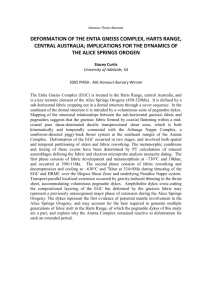U–Pb and geochemical evidence for a Cryogenian magmatic arc in
advertisement
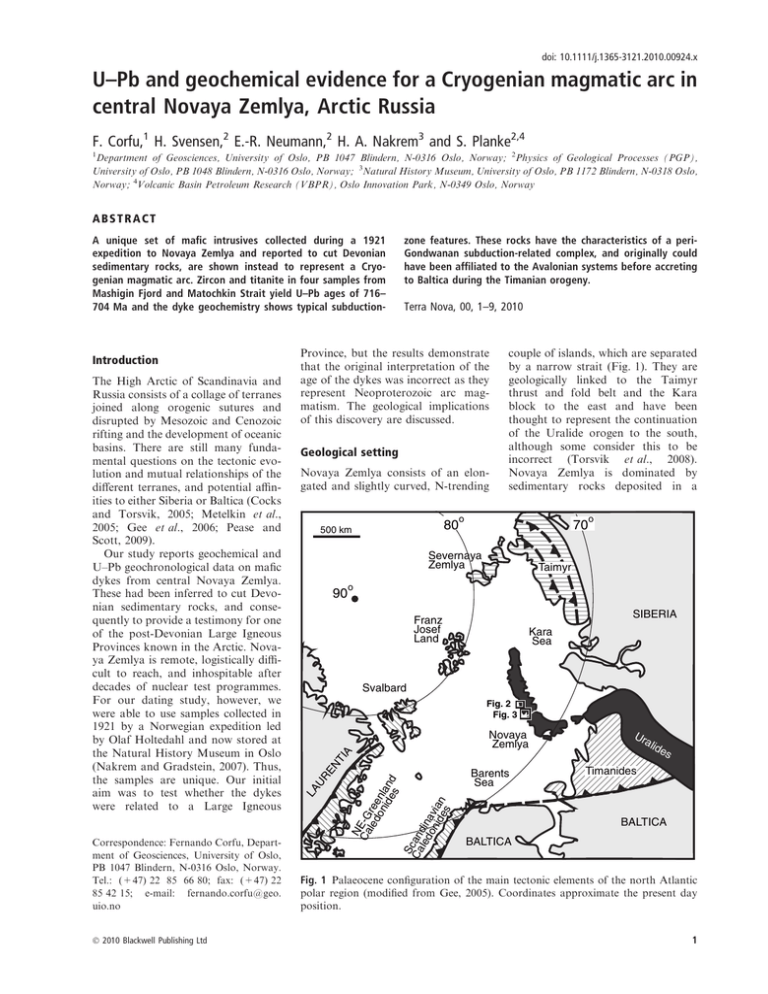
doi: 10.1111/j.1365-3121.2010.00924.x U–Pb and geochemical evidence for a Cryogenian magmatic arc in central Novaya Zemlya, Arctic Russia F. Corfu,1 H. Svensen,2 E.-R. Neumann,2 H. A. Nakrem3 and S. Planke2,4 1 Department of Geosciences, University of Oslo, PB 1047 Blindern, N-0316 Oslo, Norway; 2Physics of Geological Processes (PGP), University of Oslo, PB 1048 Blindern, N-0316 Oslo, Norway; 3Natural History Museum, University of Oslo, PB 1172 Blindern, N-0318 Oslo, Norway; 4Volcanic Basin Petroleum Research (VBPR), Oslo Innovation Park, N-0349 Oslo, Norway ABSTRACT A unique set of mafic intrusives collected during a 1921 expedition to Novaya Zemlya and reported to cut Devonian sedimentary rocks, are shown instead to represent a Cryogenian magmatic arc. Zircon and titanite in four samples from Mashigin Fjord and Matochkin Strait yield U–Pb ages of 716– 704 Ma and the dyke geochemistry shows typical subduction- 2010 Blackwell Publishing Ltd Novaya Zemlya consists of an elongated and slightly curved, N-trending 80 500 km couple of islands, which are separated by a narrow strait (Fig. 1). They are geologically linked to the Taimyr thrust and fold belt and the Kara block to the east and have been thought to represent the continuation of the Uralide orogen to the south, although some consider this to be incorrect (Torsvik et al., 2008). Novaya Zemlya is dominated by sedimentary rocks deposited in a o 70 Severnaya Zemlya 90 o Taimyr o SIBERIA Franz Josef Land Kara Sea Svalbard Fig. 2 Fig. 3 Ur ali NT I A Novaya Zemlya Barents Sea S Cacan led din on avi ide an s N CaE-G led ree on nla ide nd s Correspondence: Fernando Corfu, Department of Geosciences, University of Oslo, PB 1047 Blindern, N-0316 Oslo, Norway. Tel.: (+47) 22 85 66 80; fax: (+47) 22 85 42 15; e-mail: fernando.corfu@geo. uio.no Geological setting UR E The High Arctic of Scandinavia and Russia consists of a collage of terranes joined along orogenic sutures and disrupted by Mesozoic and Cenozoic rifting and the development of oceanic basins. There are still many fundamental questions on the tectonic evolution and mutual relationships of the different terranes, and potential affinities to either Siberia or Baltica (Cocks and Torsvik, 2005; Metelkin et al., 2005; Gee et al., 2006; Pease and Scott, 2009). Our study reports geochemical and U–Pb geochronological data on mafic dykes from central Novaya Zemlya. These had been inferred to cut Devonian sedimentary rocks, and consequently to provide a testimony for one of the post-Devonian Large Igneous Provinces known in the Arctic. Novaya Zemlya is remote, logistically difficult to reach, and inhospitable after decades of nuclear test programmes. For our dating study, however, we were able to use samples collected in 1921 by a Norwegian expedition led by Olaf Holtedahl and now stored at the Natural History Museum in Oslo (Nakrem and Gradstein, 2007). Thus, the samples are unique. Our initial aim was to test whether the dykes were related to a Large Igneous Terra Nova, 00, 1–9, 2010 Province, but the results demonstrate that the original interpretation of the age of the dykes was incorrect as they represent Neoproterozoic arc magmatism. The geological implications of this discovery are discussed. LA Introduction zone features. These rocks have the characteristics of a periGondwanan subduction-related complex, and originally could have been affiliated to the Avalonian systems before accreting to Baltica during the Timanian orogeny. de s Timanides BALTICA BALTICA Fig. 1 Palaeocene configuration of the main tectonic elements of the north Atlantic polar region (modified from Gee, 2005). Coordinates approximate the present day position. 1 Geochemistry and U–Pb age of mafic dykes, Novaya Zemlya • F. Corfu et al. Terra Nova, Vol 00, No. 0, 1–9 ............................................................................................................................................................. semi-continuous manner throughout the Palaeozoic. There is a CambroOrdovician unconformity in the south (Pease and Scott, 2009), but not in the north (Gee et al., 2006). Korago et al. (2004) also document occurrences of Neoproterozoic gabbro, lamprophyre and granite. The southern parts of Novaya Zemlya are inferred to have been part of the Timanian belt, a succession of metasedimentary and volcanic rocks evolved at the margins of Baltica and then accreted to the craton during the Timanian orogeny at 600–550 Ma (Puchkov, 1997; Gee, 2005; Pease et al., 2008; Pease and Scott, 2009). The rocks were folded in the Late Triassic to Earliest Jurassic and thrust westward by an amount originally estimated at 500–700 km (Otto and Bailey, 1995; Torsvik and Andersen, 2002), but now considered to be about 200 km (Buiter and Torsvik, 2007; Cocks and Torsvik, 2007; Scott et al., in press). Samples Three of the samples stem from Mashigin Fjord and one is from the western entrance of Matochkin Strait, which separates the northern island from the southern island (Figs 1–3). On the cross-section along the northern shore of Mashigin Fjord (Fig. 2), Holtedahl (1924) distinguished a western part with shale and limestone, locally highly fossiliferous and Lower Devonian to Permian, a central part with mainly sandstones and phyllites Fig. 2 Simplified geological map of the Mashigin area. From Tkačenko and Egiazarov (1970), modified based on descriptions from Holtedahl (1924). Precambrian age of the unfossiliferous sedimentary and volcanic rocks is inferred from our new data. Approximate sample locations are also shown. The cross-section is taken from Holtedahl (1924), but the thrust is inferred from the geological descriptions and our results. 2 intruded by north-trending diabase dykes and with some lavas, and an eastern part consisting of a variety of volcanoclastic rocks, metasandstones and local fossiliferous Devonian shales and limestones. The three samples analysed in this study represent diabase dykes from the central parts of the section. Samples NZV-288 and NZV-152 consist of a matrix of highly altered feldspar with prismatic and commonly twinned clinopyroxene (1–2 mm) locally replaced and ⁄ or surrounded by very fine-grained chlorite and ⁄ or hornblende. Sample NZV281 is finer grained (<1 mm), ophitic and largely altered, plagioclase to saussurite and the mafic minerals to amphibole, biotite, chlorite and epidote, with secondary quartz and carbonate. The petrographic features of diabase dykes in this area have been described by Backlund (1930, pp. 42–47). According to Backlund (1930, p. 17), who drew from the field descriptions of Holtedahl (1924), the intrusive rocks at Matochkin Strait (Fig. 3) occur as thick conformable sheets, locally porphyritic and finegrained. To the west, there are Lower Devonian Favosites limestone and dolomite, but the contacts to the intrusive rocks are of uncertain nature. The bottom of the westernmost intrusive body displays a schistosity suggesting faulting or west-directed thrusting (Holtedahl, 1924; Backlund, 1930). In addition, the inferred hangingwall, studied by Cissarz (1928) along its projection south of the fjord, shows the presence of contact metamorphic marbles. For the area north of the fjord, Backlund (1930) and Holtedahl (1924) mention the observation by Dietrichson of crosscutting pegmatites and quartz-veins. These could be correlative to c. 600 Ma granitic veins mentioned by Korago et al. (2004) from Sulmenev Bay farther south. Backlund (1930) states that the sedimentary rocks to the east of the intrusive sheets include strata that are at least Ozarkian (i.e. a period at the Cambro-Ordovician boundary) or younger, and he concludes that the intrusions are therefore likely postEarly Devonian. More recently, Korago et al. (2004) define the ÔMitushev kamen Granite MassifÕ as a north-trending complex exposed over roughly 40 by 3.8 km, 2010 Blackwell Publishing Ltd F. Corfu et al. • Geochemistry and U–Pb age of mafic dykes, Novaya Zemlya Terra Nova, Vol 00, No. 0, 1–9 ............................................................................................................................................................. Fig. 3 Simplified geological map of the Matochkin Strait area. From Tkačenko and Egiazarov (1970) modified based on descriptions from Holtedahl (1924) and Korago et al. (2004). Sample location is also shown. dominated by alaskite granite, and generally highly deformed, in tectonic contact to Upper Silurian and Lower Devonian sedimentary rocks. Locally, the granite is overlain unconformably by Upper Silurian sediments. Korago et al. (2004) quote Pb–Pb zircon evaporation ages of 680 ± 50 and 730 ± 50 Ma by themselves, and zircon U–Pb ages of 609 ± 4, 587 ± 7 and 717 ± 4 Ma presented in a conference report by Kaplan and co-workers. Our sample (NZV-287) is more mafic than the typical granite of this complex and corresponds to the quartz-diorite described by Backlund (1930). 2010 Blackwell Publishing Ltd U–Pb results The four samples contained comparable zircon populations dominated by euhedral long prismatic, generally highly fragmented crystals, a common type in gabbroic rocks. The U contents range from 170 to over 800 p.p.m. (Table 1) and Th ⁄ U tends to be high at 0.4 and 1.1, another common feature of zircon in gabbroic rocks. The six analyses from sample NZV-281 from Mashigin Fjord (Fig. 2) vary in terms of precision and are between 1% and 5% discordant and collinear yielding an upper intercept of 716 ± 8 Ma and a lower intercept age at 227 ± 170 Ma (Fig. 4a). The lower intercept corresponds to the time of the main Mesozoic deformation affecting the islands and it is reasonable to assume that the same disturbance also affected the other samples. Those data are thus regressed through a lower intercept of 200 Ma using a conservative uncertainty of ±100 Ma. The analyses from sample NZV-152 are variably discordant yielding an upper intercept age of 706 ± 14 Ma (Fig. 4b). The third sample from Mashigin Fjord, NZV-288, has nominally concordant data and provides an upper intercept age of 704 ± 5 Ma (Fig. 4a,c), close to the average 207 Pb ⁄ 206Pb age. Sample NZV-287 from Matochkin Strait (Fig. 3) yields a cluster of five analyses that are close to concordant and when projected from 200 ± 100 Ma intersect the Concordia curve at 707.1 ± 1.7 Ma (Fig. 4d). Cores, identified on the basis of their rounded shape inside some prisms, yield an older age at around 720 Ma. Titanite is rich in U (360– 440 p.p.m.), has high Th ⁄ U (1.5– 1.9), but also contains 3.4– 4.1 p.p.m. common Pb and hence the analyses are not very precise. The two data points overlap the zircon discordia line and can be explained either as indicating a post-crystallization event at 699– 702 Ma or slight resetting by later Pb loss. Geochemical results The Novaya Zemlya dykes show a restricted range of relatively evolved major element compositions with 50– 54 wt% SiO2 and 2.8–5.4 wt% MgO (Table 2) and classify as tholeiitic to subalkaline basalts to basaltic andesites (Fig. 5). The rocks are relatively rich in the most incompatible elements (e.g. 90–340 p.p.m. Ba, 1.8– 5.6 p.p.m. Th), but have moderate concentrations of rare earth elements (REE; e.g. 7–24 p.p.m. La; Table 2), and low to moderate concentrations of compatible elements such as Ni (5–40 p.p.m.) and Cr (95–120 p.p.m.). The most evolved sample (NZV-281 with 2.8 wt% MgO) has the highest concentrations of incompatible, and lowest of compatible 3 4 U (p.p.m.)* 4.8 7.4 0.7 1.0 0.5 0.7 0.9 1.1 0.5 0.6 1.2 2.1 2.8 35.3 3.3 2.3 1.9 4.6 14.4 15.9 0.93 0.76 0.75 0.81 0.90 1.10 0.83 0.61 0.40 1.05 0.77 1.12 0.96 0.99 0.96 0.85 0.80 0.79 1.86 1.50 Th ⁄ U Pbc (pg) 879 7254 14 850 6770 2899 567 820 4951 1555 1020 1542 236 4058 2202 1484 219 4414 2769 7568 4551 Pb z 204 Pb 206 Pb x U (abs) 1.0321 0.9979 0.9996 1.0001 0.9991 0.9907 0.9956 0.9973 0.9944 0.9951 1.0009 0.9623 0.9524 0.9991 1.0068 0.9961 0.9944 0.9548 0.9961 0.9993 235 207 0.0039 0.0027 0.0023 0.0025 0.0027 0.0055 0.0040 0.0045 0.0062 0.0072 0.0055 0.0295 0.0079 0.0046 0.0033 0.0133 0.0041 0.0041 0.0232 0.0179 ±2r Pb x U 0.11801 0.11508 0.11517 0.11529 0.11510 0.11457 0.11505 0.11511 0.11457 0.11476 0.11529 0.11349 0.11044 0.11492 0.11568 0.11462 0.11437 0.11016 0.11411 0.11463 238 206 0.00024 0.00027 0.00023 0.00024 0.00026 0.00029 0.00024 0.00046 0.00053 0.00061 0.00042 0.00076 0.00090 0.00037 0.00026 0.00050 0.00042 0.00039 0.00277 0.00217 ±2r 0.60 0.85 0.94 0.89 0.84 0.47 0.58 0.89 0.73 0.63 0.62 0.43 0.94 0.74 0.71 0.36 0.83 0.76 0.95 0.93 q Pb x Pb (abs) 0.06343 0.06289 0.06295 0.06292 0.06296 0.06271 0.06277 0.06284 0.06295 0.06289 0.06296 0.06149 0.06255 0.06306 0.06313 0.06303 0.06306 0.06286 0.06331 0.06323 206 207 0.00019 0.00009 0.00005 0.00007 0.00009 0.00031 0.00021 0.00013 0.00027 0.00036 0.00027 0.00175 0.00017 0.00020 0.00015 0.00079 0.00015 0.00018 0.00047 0.00045 ±2r Pb x U (Ma) 719.1 702.2 702.7 703.4 702.3 699.2 702.0 702.3 699.2 700.3 703.4 693.0 675.3 701.2 705.6 699.5 698.1 673.7 696.6 699.6 238 206 Pb x U 720.0 702.7 703.6 703.9 703.4 699.1 701.6 702.4 700.9 701.3 704.3 684.5 679.3 703.4 707.3 701.8 700.9 680.6 701.8 703.5 235 207 Pb x Pb 722.7 704.5 706.5 705.4 706.7 699 700.3 702.7 706.5 704 707.0 656 692.8 710.2 712.5 709 710.2 703.5 719 716 206 207 6.4 3.0 1.6 2.4 3.0 10 7.0 4.4 9.0 12 9.1 60 5.9 6.6 4.9 26 4.9 6.0 16 15 ±2r 0.5 0.3 0.6 0.3 0.7 )0.1 )0.2 0.1 1.1 0.6 0.5 )5.9 2.7 1.3 1.0 1.5 1.8 4.5 3.3 2.4 Disc (%) Geochemistry and U–Pb age of mafic dykes, Novaya Zemlya • F. Corfu et al. Z, zircon (unless otherwise specified all clear and transparent); T, titanite; eu, euhedral; an, anhedral; lp, long prismatic (l ⁄ w ‡ 4); fr, fragment; co, cores; pb, pale-brown; b, brown; r, red; pnk, pink; [1], number of grains in fraction; Pbc, total common Pb in sample (initial + blank); Disc, degree of discordancy. *Weight and concentrations are known to better than 10%, except for those near and below the 1 lg limit of resolution of the balance. Th ⁄ U model ratio inferred from 208 ⁄ 206 ratio and age of sample. àRaw data corrected for fractionation. §Corrected for fractionation, spike, blank and initial common Pb; error calculated by propagating the main sources of uncertainty. NZV-281, diabase, Mashigin Fjord Z lp-fr (eu) [5] 6 163 Z lp-fr [1] 1 208 Z fr [5] 1 442 Z fr pb [3] 1 385 Z fr [10] 1 573 Z fr [2] 1 440 NZV-152, diabase, Mashigin Fjord Z fr (eu) [1] 1 183 Z fr (eu) [1] 1 34 Z fr pnk [1] 1 310 Z fr [4] 1 191 NZV-288, diabase, Mashigin Fjord Z fr (eu) [8] 1 844 Z fr (eu) [1] 1 455 Z fr (eu) [1] 1 384 NZV-287, quartz-diorite, Matotchkin Strait Z an co [6] 17 242 Z lp-fr [30] 13 252 Z lp-fr [15] 28 172 Z lp-fr [15] 10 179 Z lp-fr [13] 10 185 T fr b-r [2] 3 367 T fr b-r [3] 4 443 Sample Weight (lg)* Table 1 U–Pb data. ............................................................................................................................................................. Terra Nova, Vol 00, No. 0, 1–9 2010 Blackwell Publishing Ltd F. Corfu et al. • Geochemistry and U–Pb age of mafic dykes, Novaya Zemlya Terra Nova, Vol 00, No. 0, 1–9 ............................................................................................................................................................. (a) NZV-281 6 pts 227 ± 170 & 716 ± 8 Ma MSWD = 0.33 (b) 710 710 NZV-152 4 pts, from 200 ± 100 Ma 706 ± 14 Ma 0.116 MSWD = 2.7 700 Zircon 700 0.114 690 Zircon 690 0.112 680 680 206Pb/238U 0.110 0.95 (c) Diabase Maschigin Fjord 0.99 0.93 NZV-288 3 pts 0.97 1.01 706 NZV-287 4 pts (d) 706 from 200 ± 100 Ma 0.1156 670 Diabase Maschigin Fjord from 200 ± 100 Ma 707.1 ± 1.7 Ma 704 ± 5 Ma MSWD = 0.42 704 MSWD = 0.65 704 0.1152 Zircon 702 702 Xenocrystic zircon Titanite 0.1148 700 722 700 718 698 Zircon 698 0.1144 0.1140 Diabase Maschigin Fjord 0.988 0.996 Quartz-diorite Matochkin Strait 696 0.984 1.004 0.992 1.000 207Pb/235U Fig. 4 (a–d) Concordia diagram with U–Pb data for zircon and titanite. The analyses were carried out by ID-TIMS (Krogh, 1973) on hand-picked and abraded (Krogh, 1982) single- or multigrain fractions of zircon and titanite. Details of the procedure are given in Corfu (2004). Decay constants are those of Jaffey et al. (1971). The initial common Pb correction, when needed, was based on Stacey and Kramers (1975). Plotting and age calculations employed the program Isoplot by Ludwig (2003). Ellipses are drawn at 2r. elements. Strontium shows a shift from positive anomalies in the most Mg-rich samples to a strong negative anomaly in the most evolved sample (Fig. 6a). The essentially parallel patterns imply that, although altered, the dykes have retained their original trace element characteristics. Normalized to primordial mantle (PM; McDonough and Sun, 1995; Fig. 6a), the data show a strong enrichment in the most incompatible elements (Cs, Rb, Ba, Th, U) relative to REE, marked negative anomalies for Nb–Ta and positive anomalies for Pb. Two of the samples also show positive K-anomalies. 2010 Blackwell Publishing Ltd Discussion Geological significance of the ages The new ages clearly demonstrate that the hypothesis of a Mesozoic (or younger) age of the dykes was incorrect. The four samples yield coherent data indicating intrusion between 716 and 704 Ma, with essentially coeval titanite, but also some older cores, in NZV-287. A Neoproterozoic age of the dykes is also consistent with the evidence reported in the literature. The geological descriptions of Mashigin Fjord (Holtedahl, 1924; Backlund, 1930) indicate that the dykes intrude unfossiliferous sedimentary rocks, separated from the fossil-bearing Devonian strata by a zone of shearing (Fig. 2). Hence, the contact is probably tectonic and the sequence hosting the dykes probably represents Precambrian strata. At Matochkin Strait (Fig. 3), the fossiliferous Devonian strata in the west are bordered by sheared diorite sheets with no evidence of contact metamorphism (Backlund, 1930). There is a contact metamorphic aureole in sedimentary rocks at the eastern edge of the main granitoid pluton, but those have no fossils. These relationships are 5 Geochemistry and U–Pb age of mafic dykes, Novaya Zemlya • F. Corfu et al. Terra Nova, Vol 00, No. 0, 1–9 ............................................................................................................................................................. Table 2 Major (wt%) and trace element (p.p.m.) concentrations for dykes from Novaya Zemlya. The data were acquired using ICP-AES ⁄ MS at the Department of Earth Sciences, Royal Holloway University of London, UK. SiO2 TiO2 Al2O3 Fe2O3 MnO MgO CaO Na2O K2O P2O5 Sum Ba Co Cr Cu Li Ni Sc Sr V Zn Zr Pb U Th Rb Nb Cs Hf Ta Tl Y La Ce Pr Nd Sm Eu Gd Tb Dy Ho Er Tm Yb Lu Mo Sn NZV152 NZV281 NZV287 NZV288 49.91 1.62 12.41 15.67 0.236 4.96 9.69 2.13 0.37 0.14 97.14 53.52 2.72 12.24 14.01 0.234 2.81 5.72 3.51 1.75 0.64 97.15 53.70 1.38 15.59 11.97 0.159 3.35 7.10 3.25 1.21 0.12 97.83 50.69 1.59 12.51 14.45 0.238 5.41 9.40 2.68 0.44 0.13 97.54 89 44 124 212 37 36 45 471 397 119 112 10 0.46 2.05 14 7.3 3.01 2.97 0.43 0.14 36 8.2 21.3 2.7 12.3 4.31 1.36 4.45 0.90 5.53 1.12 3.04 0.47 3.21 0.48 1.1 1.1 340 34 95 33 32 7 36 168 279 115 200 11 1.28 5.89 45 16.0 1.11 5.32 1.10 0.43 44 24.3 56.6 6.7 29.4 7.57 2.34 6.66 1.22 6.97 1.36 3.65 0.53 3.55 0.52 0.8 1.4 200 32 102 41 25 5 26 236 366 99 123 6 0.32 2.05 35 6.5 1.73 3.25 0.41 0.36 30 11.6 29.0 3.7 15.4 4.23 1.10 3.91 0.78 4.61 0.95 2.64 0.39 2.70 0.44 0.8 1.3 125 42 100 185 25 40 45 267 361 112 99 7 0.41 1.80 15 5.5 0.78 2.58 0.36 0.14 30 7.2 18.0 2.5 10.6 3.71 1.15 3.82 0.81 4.62 1.00 2.60 0.39 2.56 0.42 0.3 0.9 consistent with thrusting of a Neoproterozoic basement complex on the Devonian sedimentary assemblage, a relationship supported by the c. 730– 590 Ma granite dated further north (Korago et al., 2004). 6 Fig. 5 Total alkali–SiO2 classification diagram of Le Bas et al. (1986) and Kuno (1968). Also plotted for comparison is the field for amphibolites of the Yakorninsky Suite from the same location from data reported by Korago et al. (2004). The data for granites of the Sulmenesvsky and Mitushevsky Suite plot to the right of the diagram at SiO2 concentrations of 65–78% and total alkalis of 4.2–8.6%, probably affected mostly by fractionation processes. (a) (b) Fig. 6 Spidergrams comparing PM-normalized trace element abundances of the dykes in central Novaya Zemlya (a) to those of Volcán Ollagüe lavas from the Andes (b). The similarity supports an origin of the Novaya Zemlya dykes in a subduction setting. In detail, the available maps and descriptions of the region are not always clear and, in part, contradic- tory. The nature of some important contacts is speculative with evidence of intrusive contacts, unconformities 2010 Blackwell Publishing Ltd F. Corfu et al. • Geochemistry and U–Pb age of mafic dykes, Novaya Zemlya Terra Nova, Vol 00, No. 0, 1–9 ............................................................................................................................................................. Melt origin The Novaya Zemlya dykes show compositional characteristics that are typical of arc magmatism with the characteristic high Rb–Ba, strongly negative Nb–Ta-anomalies, positive K-, Pb- and Sr-anomalies and relatively flat REE patterns (e.g. Sun, 1980; Wilson, 1989). The similarity to arc lavas is emphasized in Fig. 6b where the Novaya Zemlya rocks are compared to calcalkaline lavas with similar MgO contents in one of the Central Andean stratavolcanoes, Volcán Ollagüe (Feeley and Davidson, 1994). We note the similar concentrations of incompatible elements and trace element patterns, both showing a shift from positive to negative Sranomalies accompanied by a general increase in the concentrations in other incompatible elements with decreasing MgO. This pattern is the typical result of fractional crystallization dominated by removal of feldspar. The chemical characteristics of these dykes thus support emplacement during arc magmatism rather than LIP volcanism. Regional implications: Cryogenian subduction and a peri-Gondwanan connection? Geological relationships, such as unconformities, suggest that southern Novaya Zemlya was affected by the Timanian orogeny by accreting to Baltica at about 600–550 Ma (Gee, 2005; Pease and Scott, 2009). In the investigated region, there are reports of granitic activity at 620–600 Ma (Korago et al., 2004). We notice, however, that titanite of sample NZ287 has not been affected in any strong way at 600–550 Ma, in spite of the susceptibility of this mineral to metamorphic resetting. The origin of these 716–704 Ma basement units remains uncertain. 2010 Blackwell Publishing Ltd 30o N (a) NORTH CHINA BALTICA LAURENTIA Equator S-Taimyr RIO PLATA SIBERIA Tim an ian AMAZONIA Avalon ian and thrusts. The various lines of evidence suggest that this is a zone of imbrication formed by juxtaposition of slivers of Palaeozoic and Precambrian rocks, the latter locally with an unconformable Palaeozoic sedimentary cover. These units were folded and tectonically interleaved during westward thrusting, presumably in the Late Triassic (Otto and Bailey, 1995). Baikalian 30o S 750 Ma (b) SIBERIA 30o N NORTH CHINA KARA LAURENTIA Equator RIO PLATA AMAZONIA BALTICA 30o S Fig. 7 Hypothetical continental configurations at 750 Ma: (a) Baltica in an upside-down position as proposed by Hartz and Torsvik (2002); from Cocks and Torsvik (2005). (b) Baltica in the conventional orientation, here in the position given by Li et al. (2008). There is no record of magmatism at this time in the present northern regions of the Baltic Shield, except for the Caledonian Kalak Nappe of Finnmark that, however, has an affinity to Laurentian and western Gondwana elements and probably originated outside of Baltica (Kirkland et al., 2006, 2007, 2008; Corfu et al., 2007). The Kalak Nappes were thrust on Baltic basement during the Caledonian orogeny (e.g. Corfu et al., 2006), while Novaya Zemlya had already joined Baltica at 600– 550 Ma (Roberts and Siedlecka, 2002). Neoproterozoic elements are also present in the central Taimyr terranes, now welded to northern Siberia (e.g. Pease et al., 2001; Metelkin et al., 2005; Pease and Scott, 2009). Pease and Persson (2006) document c. 700 Ma island arc volcanism in northern Taimyr. The Enganepe ophiolite, now part of the Uralian orogen, developed at 670 Ma in an oceanic island arc setting and was then thrust on Baltica during the Timanian convergence (Scarrow et al., 2001). The events at 716–704 Ma also correlate with arc magmatism recorded on different margins of the Siberian craton (Amelin et al., 1996; Vernikovsky et al., 2003, 2004). In more general terms, it also fits with the protracted activity recorded in the peri-Gondwanan realm. There is still much uncertainty on the Neoproterozoic configuration of the continents, depending on variable interpretations of palaeomagnetic evidence and geological constraints. The model proposed by Hartz and Torsvik (2002) (Fig. 7a) considers that Baltica was in an upside-down position in the Cryogenian. In this configuration, the arc magmatism in Novaya Zemlya and Timanian convergence can easily be explained within the framework of the magmatic arcs developed at the periphery of Gondwana (e.g. Roberts and Siedlecka, 2002). A class of alternative models, such as that discussed by Li et al. (2008), place Baltica at the edge of Rodinia and arc magmatism is inferred to have been active along this margin, potentially linking the development of Novaya Zemlya to coeval successions in Siberia, China and elsewhere (Fig. 7b). Conclusions A study of the geochemistry and age of dykes collected during the 1921 Norwegian Arctic expedition has shown that intrusions of mafic rocks in central Novaya Zemlya were related to arc magmatism in the Cryogenian at 716–704 Ma. The hosting sedimentary succession is therefore of Precambrian age, rather than Devonian. The major and trace element geochemistry shows Andean-type signatures, suggesting emplacement in a subduction setting. A connection with the peri-Gondwanan realm most easily explains the tectonic relationships, the alternative requiring the existence of an independent arc system or extensive translation of terranes. Acknowledgements We thank Morten Schjoldager for preparing the mineral separates and acknowledge constructive reviews by V. Pease, B. Bingen and D. Gee. 7 Geochemistry and U–Pb age of mafic dykes, Novaya Zemlya • F. Corfu et al. Terra Nova, Vol 00, No. 0, 1–9 ............................................................................................................................................................. References Amelin, Y.V., Neymark, L.A., Ritsk, E.Y. and Nemchin, A.A., 1996. Enriched NdSr-Pb isotopic signatures in the Dovyren layered intrusion (eastern Siberia, Russia): evidence for source contamination by ancient upper-crustal material. Chem. Geol., 129, 39–69. Backlund, H.G., 1930. Die Magmagesteine der Geosynklinale von Nowaja Semlja. In: Report of the Scientific Results of the Norwegian Expedition to Novaya Zemlya 1921 (O. Holtedahl, ed.), 63 pp. No. 45. Det norske Videnskaps-akademi i Oslo, Oslo. Buiter, S.J.H. and Torsvik, T.H., 2007. Horizontal movements in the eastern Barents Sea constrained by numerical models and plate reconstructions. Geophys. J. Int., 171, 1376–1389. Cissarz, A., 1928. Petrographische Untersuchungen von Sedimentgesteinen aus Nowaja Semlja und deren metamorphe Umwandlungen. In: Report of the Scientific Results of the Norwegian Expedition to Novaya Zemlya 1921 (O. Holtedahl, ed.), 66 pp. No. 37. Det norske Videnskaps-akademi i Oslo, Oslo. Cocks, L.R.M. and Torsvik, T.H., 2005. Baltica from the late Precambrian to mid-Palaeozoic times: the gain and loss of a terraneÕs identity. Earth Sci. Rev., 72, 39–66. Cocks, L.R.M. and Torsvik, T.H., 2007. Siberia, the wandering northern terrane, and its changing geography through the Palaeozoic. Earth Sci. Rev., 82, 29–74. Corfu, F., 2004. U-Pb age, setting, and tectonic significance of the anorthositemangerite-charnockite-granite-suite, Lofoten-Vesterålen, Norway. J. Petrol., 45, 1799–1819. Corfu, F., Torsvik, T.H., Andersen, T.B., Ashwal, L.D., Ramsay, D.M. and Roberts, R.J., 2006. Early Silurian maficultramafic and granitic plutonism in contemporaneous flysch, Magerøy, northern Norway: U-Pb ages and regional significance. J. Geol. Soc. London, 163, 291–301. Corfu, F., Roberts, R.J., Torsvik, T.H., Ashwal, L.D. and Ramsay, D.M., 2007. Peri-gondwanan elements in the Caledonian nappes of Finnmark, northern Norway: implications for the paleogeographic framework of the Scandinavian Caledonides. Am. J. Sci., 307, 434–458. Feeley, T.C. and Davidson, J.P., 1994. Petrology of calc-alkaline lavas at Volcán Ollagüe and the origin of compositional diversity at Central Andean stratavolcanoes. J. Petrol., 35, 1295–1340. Gee, D.G., 2005. Timanides of Northern Russia. In: Encyclopedia of Geology 2 (R.C. Selley, L.R.M. Cocks and I.R. Plimer, eds), pp. 49–56. Elsevier, Oxford. Gee, D.G., Bogolepova, O.K. and Lorenz, H., 2006. The Timanide, Caledonide and 8 Uralide orogens in the Eurasian high Arctic, and relationships to the palaeocontinents Laurentia, Baltica and Siberia. In: European Lithosphere Dynamics (D.G. Gee and R. Stephenson, eds). Geol. Soc. London Mem., 32, 507–520. Hartz, E.H. and Torsvik, T.H., 2002. Baltica upside-down: a new plate-tectonic model for Rodinia and the Iapetus Ocean. Geology, 30, 255–258. Holtedahl, O., 1924. On the rock formations of Novaya Zemlya, with notes on the Paleozoic stratigraphy of other Arctic lands. In: Report of the Scientific Results of the Norwegian Expedition to Novaya Zemlya 1921 (O. Holtedahl, ed.), 183 pp. No. 22. Det norske Videnskapsakademi i Oslo, Oslo. Jaffey, A.H., Flynn, K.F., Glendenin, L.E., Bentley, W.C. and Essling, A.M., 1971. Precision measurement of half-lives and specific activities of U235 and U238. Phys. Rev. Sec. C Nucl. Phys., 4, 1889–1906. Kirkland, C.L., Daly, J.S. and Whitehouse, M.J., 2006. Granitic magmatism of Grenvillian and late Neoproterozoic age in Finnmark, Arctic Norway: constraining pre Scandian deformation in the Kalak Nappe Complex. Precambrian Res., 145, 24–52. Kirkland, C.L., Daly, J.S. and Whitehouse, M.J., 2007. Provenance and terrane evolution of the Kalak Nappe Complex, Norwegian Caledonides: implications for Neoproterozoic palaeogeography and tectonics. J. Geol., 115, 21–41. Kirkland, C.L., Daly, J.S. and Whitehouse, M.J., 2008. Basement-cover relationships of the Kalak Nappe Complex, Arctic Norwegian Caledonides and constraints on Neoproterozoic terrane assembly in the North Atlantic region. Precambrian Res., 160, 245–276. Korago, E.A., Kovaleva, G.N., Lopatin, B.G. and Orgo, V.V., 2004. The Precambrian rocks of Novaya Zemlya. In: The Neoproterozoic Timanide Orogen of Eastern Baltica (D.G. Gee and V.L. Pease, eds). Geol. Soc. London Mem., 30, 135–143. Krogh, T.E., 1973. A low contamination method for hydrothermal decomposition of zircon and extraction of U and Pb for isotopic age determinations. Geochim. Cosmochim. Acta, 37, 485–494. Krogh, T.E., 1982. Improved accuracy of U–Pb zircon ages by the creation of more concordant systems using an air abrasion technique. Geochim. Cosmochim. Acta, 46, 637–649. Kuno, H., 1968. Differentiation of basalt magmas. In: Basalts – Poldervaart Treaties of Rocks of Basalt Composition 2 (H.H. Hess and A. Poldervaart, eds), pp. 623–688. John Wiley and Sons, New York. Le Bas, M.J., Le Maitre, R.W., Streckeisen, A. and Zanettin, B., 1986. A chem- ical classification of volcanic rocks based on the total alkali-silica diagram. J. Petrol., 27, 745–750. Li, Z.X., Bogdanova, S.V., Collins, A.S., Davidson, A., De Waele, B., Ernst, R.E., Fitzsimons, I.C.W., Fuck, R.A., Gladkochub, D.P., Jacobs, J., Karlstrom, K.E., Lu, S., Natapov, L.M., Pease, V., Pisarevsky, S.A., Thrane, K. and Vernikovsky, V., 2008. Assembly, configuration, and break-up history of Rodinia: a synthesis. Precambrian Res., 160, 179–210. Ludwig, K.R., 2003. Isoplot 3.0. A Geochronological Toolkit for Microsoft Excel, 70pp. Berkeley Geochronology Center Special Publication No. 4, Berkeley, (CA, USA). McDonough, W.F. and Sun, S.-S., 1995. The composition of the Earth. Chem. Geol., 120, 223–253. Metelkin, D.V., Vernikovsky, V.A., Kazansky, A.Yu., Bogolepova, O.K. and Gubanov, A.P., 2005. Paleozoic history of the Kara microcontinent and its relation to Siberia and Baltica: paleomagnetism, paleogeography and tectonics. Tectonophysics, 398, 225–243. Nakrem, H.A. and Gradstein, F.M., 2007. Novaya Zemlya – the Holtedahl 1921 expedition and the valuable collection of rocks from an inaccessible part of the Russian Arctic. NGF Abstr. Proc., 1, 67. Otto, S.C. and Bailey, R.J., 1995. Tectonic evolution of the northern Ural Orogen. J. Geol. Soc. London, 152, 903–906. Pease, V. and Persson, S., 2006. Neoproterozoic island arc magmatism of northern Taimyr. In: Proceedings of the Fourth International Conference on Arctic Margins. Minerals Management Service OCS Study MMS 2006-003 (R. Scott and D. Thurston, eds), pp. 31–49. US Department of Interior, Washington, DC, USA. Pease, V. and Scott, R.A., 2009. Crustal affinities in the Arctic Uralides, northern Russia: significance of detrital zircon ages from Neoproterozoic and Palaeozoic sediments in Novaya Zemlya and Taimyr. J. Geol. Soc. London, 166, 517–527. Pease, V., Gee, D.G., Vernikovskaya, V., Vernikovskaya, A. and Kireev, S., 2001. Geochronological evidence for lateGrenvillian magmatic and metamorphic events in central Taimyr, northern Siberia. Terra Nova, 13, 264–280. Pease, V., Daly, J.S., Elming, S.-Å., Kumpulainen, R., Moczydlowska, M., . Puchkov, V., Roberts, D., Saintot, A. and Stephenson, R., 2008. Baltica in the Cryogenian, 850–630 Ma. Precambrian Res., 160, 46–65. Puchkov, V.N., 1997. Structure and geodynamics of the Uralian orogen. Geol. Soc. London Spec. Publ., 121, 201–236. Roberts, D. and Siedlecka, A., 2002. Timanian orogenic deformation along 2010 Blackwell Publishing Ltd Terra Nova, Vol 00, No. 0, 1–9 F. Corfu et al. • Geochemistry and U–Pb age of mafic dykes, Novaya Zemlya ............................................................................................................................................................. the northeastern margin of Baltica, Northwest Russia and Northeast Norway, and Avalonian–Cadomian connections. Tectonophysics, 352, 169–184. Scarrow, J.H., Pease, V., Fleutelot, C. and Dushin, V., 2001. The late Neoproterozoic Enganepe ophiolites, Polar Urals, Russia: an extension of the Cadomian arc? Precambrian Res., 110, 255–275. Scott, R.A., Howard, J.P., Guo, L., Schekoldin, R. and Pease, V., 2010. Offset and curvature of the Novaya Zemlya fold-and-thrust belt, Arctic Russia. In: From Mature Basins to New Frontiers (S. Pickering et al., eds). Geol. Soc. London Spec. Publ. (in press). Stacey, J.S. and Kramers, J.D., 1975. Approximation of terrestrial lead isotope evolution by a two-stage model. Earth Planet. Sci. Lett., 34, 207–226. 2010 Blackwell Publishing Ltd Sun, S.S., 1980. Lead isotopic study of young volcanic rocks from mid-ocean ridges, ocean islands and island arcs. Phil. Trans. Roy. Soc. London, 297, 409–445. Tkačenko, B.V. and Egiazarov, B.H. (eds), 1970. Geologia SSSR Vol. XXVI. Ostrova Sovetskoj Arktiki [Geology of the USSR. Soviet Arctic Islands]. IzdatelÕstvo ‘‘Nedra’’, Moscow, 547 pp. Torsvik, T.H. and Andersen, T.B., 2002. The Taimyr Fold Belt, Arctic Siberia: timing of pre-fold remagnetisation and regional tectonics. Tectonophysics, 352, 335–348. Torsvik, T.H., Cocks, M. and Buiter, S.J.H., 2008. The Variscides, Uralides and Pangea assembly: insights from plate reconstructions and numerical modelling. 33IGC, Abstract. Available at: http://www.33igc.org/coco/Handlers/ COCO/Search.aspx?pageid=5002& tab=0#. Vernikovsky, V.A., Vernikovskayaa, A.E., Kotov, A.B., SalÕnikova, E.B. and Kovach, V.P., 2003. Neoproterozoic accretionary and collisional events on western margin of the Siberian craton: new geological and geochronological evidence from the Yenisey Ridge. Tectonophysics, 375, 147–168. Vernikovsky, V.A., Vernikovskaya, A.E., Pease, V.L. and Gee, D.G., 2004. Neoproterozoic orogeny along the margins of Siberia. Geol. Soc. London Mem., 30, 233–248. Wilson, M., 1989. Igneous Petrology. Unwin Hyman, London, 466 pp. Received 14 May 2009; revised version accepted 14 December 2009 9
